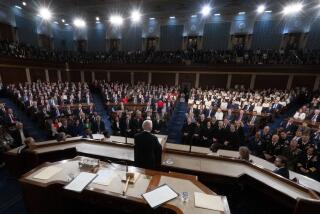AFTERSHOCKS - PHYCHIC AND OTHERWISE : The Public Investment That Built America
- Share via
NEW YORK — The disaster created by the Northridge earthquake, together with continuing pressures to curb domestic federal spending, have forged a political opportunity to deal with both problems.
California, already financially strained be cause of its weak economy, must now spend billions of dollars to rebuild roads, bridges and other infrastructure damaged by the quake. There will be a sterile argument in Congress about whether disaster relief should be offset by spending cuts or treated as an “off-budget” item. What California, along with every other state in the Union, needs is federal assistance in the form of public investment.
Such public investment, if properly financed, should never be part of the federal budget. The fact that investment in a school building or a bridge is treated as if it were next week’s welfare payment is economic nonsense. But like so much economic nonsense, it has strong political support. An attempt should now be made to step away from this trap by creating a free-standing, independently financed public corporation to assist state and local governments with their investments.
An aggressive, long-term federally assisted public-works construction program is an economic and social necessity. Investing $25 billion to $35 billion annually could generate from 800,000 to 1,000,000 jobs each year; could be part of a targeted defense-conversion plan and, if combined with Civilian Conservation Corps-type training camps, could provide training and employment for inner-city youth. It would also be psychologically uplifting at a time when fear of new layoffs in the private sector, as well as of cutbacks in state and local governments, is pervasive.
The challenge is to create a structure that could serve as the centerpiece for such a program. New York’s Municipal Assistance Corp. could be a useful model.
MAC was created, in 1975, by the state of New York to provide financing for New York City, then in serious financial difficulties. Between 1975 and 1984, it raised nearly $10 billion. Through the sale of MAC bonds, backed by a portion of the city sales tax, New York City was able to significantly increase its investment in its physical facilities. Since 1985, MAC has been paying down its debt and will retire its bonds by 2008.
A similar approach, using a longer time frame, should be adopted at the federal level. We need not start with the largest possible program. Rather, the initial goal should be limited, though capable of expansion if the program works. To illustrate, let’s consider a $200-billion, 10-year effort.
The federal government would create the “Public Investment Assistance Corp.” with authorized capital of $20 billion and $200 billion of borrowing authority. The PIAC would provide incremental financing to state and local governments over a 10-year period on a matching-fund basis. Washington would contribute 80% of the funds, which would be generated by sales of PIAC bonds, guaranteed by the U.S. government. The remaining 20% would be provided by participating states on an equity basis reflecting their distribution share--for example, a state eligible for 4% of the funds would be responsible for 4% of the capital.
Revenues could perhaps be generated by raising the federal gasoline tax by 2 cents a year for five years--equaling about $2 billion annually. The revenue stream, which would build to $10 billion to $12 billion a year after five years, would support a 10-year, $200-billion borrowing and investment program and fully service and retire the outstanding bonds after 40 years. The federal guarantee would only come into play if Congress interrupted the revenue stream. The debt-service coverage should result in an investment-grade rating for the bonds--which would make them eligible for pension-fund investment.
Right now, the total amount of private and public pension funds is about $3 trillion. This is expected to double over the next 10 years. A $200-billion, 10-year, public-investment program could be entirely funded by the commitment of less than 10% of the increase in pension funds becoming available over the same period.
Naturally, the bonds would have to meet the most stringent fiduciary standards; they could also be sold to the general investing public. The only federal budgetary cost would be the value of the guarantee (no more than 1% to 2% of principal) and the PIAC cash flow and borrowing should be totally off-budget. A strong control mechanism, such as MAC’s board of directors--consisting entirely of independent, private-sector directors--would insure funds were used prudently.
The political problem is obviously the imposition of additional energy taxes. But an annual increase of 2 cents a gallon for five years, earmarked for new construction and job creation, seems a small price to pay. Oil prices are now at their lowest level, in real terms, in the past 30 years. In addition, there was no public outcry over the 4-cent gas tax included in the deficit-reduction plan.
The requirement of a 20% local share may be a problem for some states--but cost sharing is probably a necessity. The subscription, however, would take place over time in proportion to the overall borrowing program. The program should also provide that some investments would generate their own revenues--toll roads, bridges, etc.--that could be used for further expansion or accelerated debt repayment.
The nation’s economic well-being has historically been dependent on public investment--under both Democratic and Republican presidents. Franklin D. Roosevelt helped steer America through the Depression, in part, through the activities of the Reconstruction Finance Corp. and other significant public projects. These dealt with urban and rural problems, with electrification and water, with roads and bridges. In the 1950s, Dwight D. Eisenhower launched the interstate highway program, which helped sustain an economic boom well into the 1960s.
At a time when we are looking for ways to fight crime, offset job losses in the private sector and improve the quality of urban life, a significant public-investment program is long overdue. It should appeal to Republicans and Democrats alike. It would be a fitting part of President Bill Clinton’s call for change and for investment in America.
More to Read
Sign up for Essential California
The most important California stories and recommendations in your inbox every morning.
You may occasionally receive promotional content from the Los Angeles Times.










